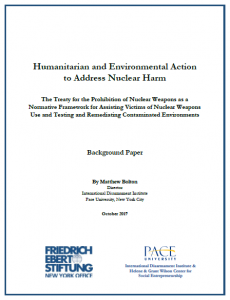 The development, production, testing and use of nuclear weapons has had catastrophic humanitarian and ecological consequences on people and environments around the world. ‘Nuclear harm’ – the damage caused by blast, incendiary and radioactive effects of nuclear weapons use, testing and production, as well as by other nuclear technologies – poses threats to the pursuit of the 2030 Sustainable Development Agenda.
The development, production, testing and use of nuclear weapons has had catastrophic humanitarian and ecological consequences on people and environments around the world. ‘Nuclear harm’ – the damage caused by blast, incendiary and radioactive effects of nuclear weapons use, testing and production, as well as by other nuclear technologies – poses threats to the pursuit of the 2030 Sustainable Development Agenda.
A new report from Pace University’s International Disarmament Institute explores possibilities for new global humanitarian and environmental action to address nuclear harm.
Due to advocacy by the International Campaign to Abolish Nuclear Weapons (ICAN), recognized by the 2017 Nobel Peace Prize, the new Treaty on the Prohibition of Nuclear Weapons (TPNW) established ‘positive obligations’ on affected states to assist victims of nuclear weapons use and testing and to remediate contaminated environments. To ensure that the burden does not fall unduly on affected states, the TPNW requires all states to engage in international cooperation and assistance to achieve these and the treaty’s other goals. While the TPNW does not explicitly cover all forms of nuclear harm, and the universalization of the treaty may take some time, its implementation offers the opportunity to build a normative framework and institutional architecture for humanitarian and environmental action to address nuclear harm.
In implementing the TPNW’s positive obligations, states should draw on lessons learned from implementing the victim assistance, clearance and risk reduction provisions in other humanitarian disarmament treaties, including the Antipersonnel Mine Ban Treaty (MBT), Convention on Certain Conventional Weapons (CCW) Protocol V on Explosive Remnants of War (ERW Protocol) and the Convention on Cluster Munitions (CCM). In particular, as they implement victim assistance and environmental remediation efforts to address nuclear harm, states, international and regional organizations and civil society should work together in:
- Supporting needs assessments at the local, national and global levels, to assess the scope of ongoing humanitarian and environmental harm caused by nuclear weapons, before the First Meeting of States Parties of the TPNW,
- Ensuring participation of survivors and affected communities in all stages of assessment, planning, implementation, monitoring and evaluation,
- Establishing rigorous national implementation measures, including administrative structures, policies, focal points and standards,
- Formulating and adopting an Action Plan at the First Meeting of States Parties,
- Convening international discussions on governing principles and quality standards rooted in international humanitarian, human rights and environmental norms,
- Encouraging public and private donors to engage in international cooperation and assistance to address nuclear harm (perhaps through a voluntary trust fund) and inviting States Not Party to contribute Official Development Assistance,
- Building a community of practice by establishing linkages between organizations already implementing relevant programs, through meetings, workshops and sharing of lessons learned,
- Establishing systems to monitor and evaluate progress.
To read the full report, click here.
